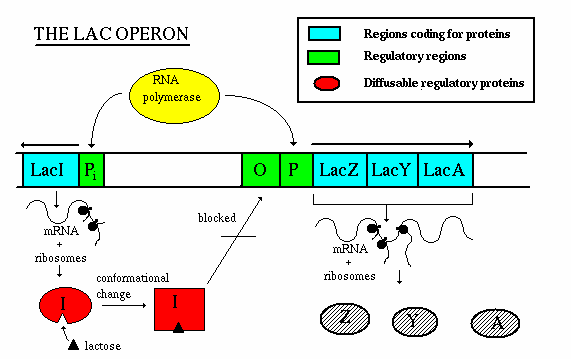
| Positive Regulation: | Negative Regulation: | |
| 1. Purpose | Primarily for decisions about utilizing the best sources of carbon, nitrogen, electron donor, electron acceptor, etc. | Primarily for decisions about whether to synthesize something that might be available from the environment. |
| 2. Protein required | An activator | A repressor |
| 3. Effectors: small molecules that act as signals. | Inducer - In positive regulation, an inducer will bind and activate the activator protein. | a. Co-repressors - repressors may not function unless they are
first bound to a small co-repressor molecule.
b. Inducer - repression may be relieved when a small inducer binds and inactivates the repressor. |
| 4. Relevant DNA sequences - | Specific activator binding sites are recognized by activator proteins. | Specific operator sites are recognized by repressors. |
| 5. Examples: | The activator protein CAP (Catabolite Activator Protein) of E. coli interacts with the inducer cAMP. The protein subsequently binds CAP binding sites in DNA and stimulates transcription of downstream genes. This system is involved in the use of alternate carbon sources when the primary source, glucose, is in short supply. | The lac repressor binds the inducer (allo)lactose. This relieves repression of transcription of the lac operon and allows the expression of genes encoding proteins involved in the metabolism of lactose when other carbon sources (e.g. glucose) are not available. |

1. Glucose is the favorite carbon source of E. coli.
However, other sugars such as lactose can
be utilized if glucose is in short supply.
2. Relevant molecules:
a. Lactose - a disaccharide containing
one glucose and one galactose residue. In order for
it to serve as a carbon/energy source, the enzyme beta-galactosidase
must
cleave lactose into its component monosaccharides: galactose and glucose.
b. cAMP - a "starvation signal";
elevated levels of this molecule indicate that the supply
of glucose is low.
3. Some observations: E. coli growth curves in the presence
of various carbon sources.
In cultures containing glucose and lactose, the
glucose is completely exhausted before the
cells begin utilizing the lactose. There is a pause
in growth during the transition from
metabolizing the two carbon sources, during which
time the cells are synthesizing the
proteins required for using lactose (i.e.
the lac operon is being expressed).
4. Catabolite repression and cAMP/CAP activation
a. CAP (Catabolite Activator Protein) - an
activator protein; functions as an activator only
when cAMP is bound
b. Levels of cAMP are inversely proportional to
glucose levels. i.e. when [glucose] is high,
[cAMP] is low and when [glucose]
is low, [cAMP] is high (this is the reason that cAMP
is a "starvation signal"-
it indicates that there is not much glucose around).
When bound with cAMP, CAP
binds the CAP binding site located just ahead of the
promoter. This facilitates
the binding of RNA polymerase at the promoter. It is important
to note that this positive
regulatory system is necessary but not sufficient to express the
lac operon. Utilizing
carbon sources other than glucose requires two signals:
5. Induction of the lac operon: relief of repression
a. When glucose is in short supply and lactose
is absent, cAMP-CAP will be bound to the
CAP binding site
but the lac repressor will still be bound to the lac operator.
The lac
repressor physically blocks
the access of RNA polymerase to the lac promoter. Thus
repression will not be relieved
under these conditions. This makes sense - since lactose
is absent, there is no need
to transcribe the genes encoding proteins required to degrade
lactose!
b. When glucose is in short supply and lactose is present,
the inducer (allo)lactose binds
the lac repressor
and causes it to be removed from the lac operator. This allows RNA
polymerase to transcribe
the genes encoding proteins needed for lactose metabolism.